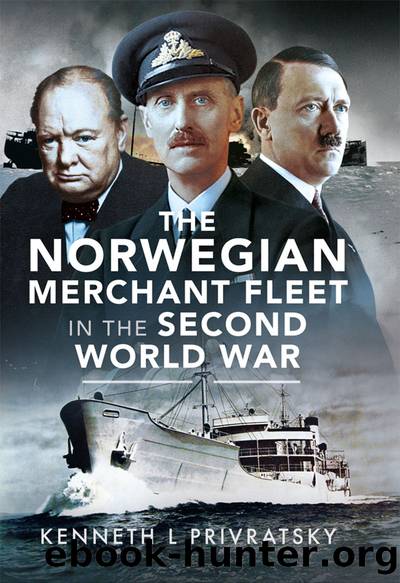The Norwegian Merchant Fleet in the Second World War by Kenneth L. Privratsky

Author:Kenneth L. Privratsky [Kenneth L. Privratsky]
Language: eng
Format: epub
ISBN: 9781399043908
Google: pkK8EAAAQBAJ
Publisher: Pen & Sword
Published: 2023-07-29T21:00:00+00:00
Chapter 7
Britain Looks for More Help as Nortraship Priorities Differ
When Churchill expressed his concerns about merchant shipping at the end of 1940, Germanyâs strategy for its submarines had just begun to change. For the first year of the war the U-boats had stalked ships independently, mostly in waters close to the British Isles. Convoys had proved quite effective in reducing the threat, but the vast expanse of the Atlantic meant they could not be protected all the way across. Escorts were concentrated on the few hundred miles at each side of the Atlantic, the Canadian navy helping as ships neared North America. In October 1940 refuelling bases were established in Ireland which extended protection about 400 miles to the west. It was not until April 1941 that construction of further refuelling bases in Iceland permitted greater protection in the central North Atlantic. ¹ The requirement to protect tankers on the long supply routes to the Middle East continued to deplete the number of escorts available, however, and this offered the perfect opportunity for the new German strategy of employing submarines in groups known as âwolfpacksâ.
After Germanyâs conquest of France, the Naval High Command in Berlin deployed U-boats to the French coast and established a headquarters nearby to communicate with the fleet at sea and relay commands. The number of ocean-going U-boats had by this time mushroomed from a couple of dozen at the start of the war to about a hundred. By the end of 1940, the fleet would double to two hundred, and although many had still not been deployed because crews were in training, many more were organized into wolfpacks. Most would deploy to the North Atlantic, although some would form off Gibraltar to intercept convoys heading south or trying to enter the Mediterranean.² The new strategy employed U-boats in groups of half a dozen to a couple of dozen to patrol a wide stretch of sea in search of convoys. As soon as one spotted a target, it reported the location to the headquarters in France, which then issued orders to other U-boats in the pack to close in. The U-boat which spotted the target would continue shadowing the ships until others arrived, and then captains would initiate individual attacks against the ships they encountered. Attacks generally took place in the evening, when the U-boats could use darkness to their advantage, often surfacing to do so. It did not take long for the Germans to see results. In October 1940, one of the first wolfpacks consisting of seven U-boats attacked a convoy of thirty-four ships with six escorts en route from Sydney, Nova Scotia to Liverpool. It sank twenty of the merchant ships. When it had completed its attack on that convoy it detected another with four dozen ships heading from Halifax to Liverpool. It sank fourteen of those, raising the total losses to thirty-four in a matter of a couple of days.
As 1941 opened, the wolfpacks continued to be deployed. It was not long before losses of ships crossing the Atlantic exceeded those around the British Isles.
Download
This site does not store any files on its server. We only index and link to content provided by other sites. Please contact the content providers to delete copyright contents if any and email us, we'll remove relevant links or contents immediately.
Room 212 by Kate Stewart(4113)
The Crown by Robert Lacey(4113)
Endurance: Shackleton's Incredible Voyage by Alfred Lansing(3853)
The Iron Duke by The Iron Duke(3650)
The Rape of Nanking by Iris Chang(3525)
Killing England by Bill O'Reilly(3460)
Joan of Arc by Mary Gordon(3268)
Say Nothing by Patrick Radden Keefe(3068)
I'll Give You the Sun by Jandy Nelson(2845)
Hitler's Monsters by Eric Kurlander(2736)
Shadow of Night by Deborah Harkness(2725)
Margaret Thatcher: The Autobiography by Thatcher Margaret(2688)
Mary, Queen of Scots, and the Murder of Lord Darnley by Alison Weir(2680)
Darkest Hour by Anthony McCarten(2650)
Blood and Sand by Alex Von Tunzelmann(2611)
Red Famine: Stalin's War on Ukraine by Anne Applebaum(2468)
Eleanor & Park by Rainbow Rowell(2398)
The One Memory of Flora Banks by Emily Barr(2350)
Book of Life by Deborah Harkness(2269)
